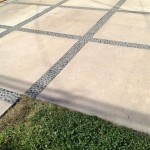Average Cost to Install a Paver Patio: A Comprehensive Guide
Installing a paver patio can significantly enhance the aesthetic appeal and functionality of an outdoor living space. Beyond providing an attractive area for relaxation and entertainment, a well-designed and professionally installed paver patio can increase a property's value. However, understanding the costs associated with this type of project is crucial for proper budgeting and informed decision-making. This article will provide a detailed overview of the factors influencing the average cost to install a paver patio, offering insights into material expenses, labor charges, and potential hidden costs.
The average cost to install a paver patio can range widely, typically falling between $10 and $30 per square foot. This range reflects the variability in material choices, project complexity, site preparation requirements, and regional labor rates. To arrive at an accurate estimate for a specific project, a thorough assessment of these factors is necessary.
Factors Influencing Paver Patio Installation Costs
Several key factors contribute to the overall cost of installing a paver patio. Understanding these factors is essential for homeowners to effectively manage their budget and avoid unexpected expenses. These include the type of paver material selected, the size and complexity of the patio design, the existing site conditions and the necessary preparation work, and the prevailing labor rates in the area.
Paver Material Costs
The type of paver material is a primary driver of the overall project cost. Pavers are available in a wide range of materials, each with its own price point and aesthetic characteristics. Concrete pavers are generally the most affordable option, typically ranging from $3 to $8 per square foot. They are durable and come in various shapes, sizes, and colors, making them a popular choice for homeowners looking for a cost-effective solution.
Brick pavers offer a classic and timeless look, but they are generally more expensive than concrete pavers, averaging $5 to $12 per square foot. The inherent beauty and durability of brick make it a desirable option, despite the higher price. Natural stone pavers, such as flagstone, bluestone, and travertine, represent the higher end of the price spectrum, ranging from $8 to $30 or more per square foot. These materials offer unique textures and natural variations, providing a luxurious and upscale aesthetic. The cost of natural stone pavers can fluctuate significantly depending on the type of stone, its availability, and the quarry location.
Permeable pavers, designed to allow water to drain through the surface, can also be used for patio installations. These pavers can help reduce stormwater runoff and are often required in areas with strict environmental regulations. Permeable pavers generally cost more than standard concrete pavers, ranging from $6 to $15 per square foot.
Patio Size and Design Complexity
The size of the patio directly impacts the total material cost and labor hours required for installation. A larger patio will naturally require more pavers, base materials, and labor to complete. Furthermore, the complexity of the patio design can also significantly influence the cost. Simple rectangular or square patios are typically less expensive to install than more intricate designs with curves, patterns, or integrated features like fire pits or seating walls.
Complex designs require more precise cutting and fitting of pavers, which can increase labor time and material waste. Incorporating features such as steps, retaining walls, or drainage systems will also add to the overall cost. Homeowners should carefully consider the desired size and design complexity of their paver patio and weigh the cost against their budget and aesthetic preferences.
Site Preparation and Existing Conditions
The condition of the existing site plays a critical role in determining the amount of preparation work needed before paver installation. If the site is uneven, sloped, or has poor drainage, significant excavation, grading, and soil compaction may be necessary. Removing existing concrete, asphalt, or other structures will also add to the project cost. Proper site preparation is essential for ensuring the long-term stability and durability of the paver patio.
In some cases, underground utilities may need to be relocated or protected before installation can begin, further increasing the cost. Addressing drainage issues is crucial to prevent water from pooling on the patio surface, which can lead to erosion, paver displacement, and potential structural damage. Installing proper drainage systems, such as French drains or surface drains, can add to the overall cost but can mitigate long-term maintenance issues.
Labor Costs and Regional Variations
Labor costs constitute a significant portion of the total paver patio installation expense. Labor rates can vary considerably depending on the geographic location, the experience and expertise of the installation crew, and the complexity of the project. Areas with a higher cost of living typically have higher labor rates. Obtaining quotes from multiple contractors is essential to ensure competitive pricing and to assess the quality of workmanship.
Experienced and reputable contractors may charge higher rates, but they are more likely to complete the project efficiently and to a high standard. Inexperienced or unlicensed contractors may offer lower prices, but they may lack the necessary skills and knowledge to properly install the paver patio, potentially leading to costly repairs or rework in the future. Checking references and reviewing online reviews can help homeowners assess the reputation and reliability of potential contractors.
Additional Costs to Consider
Beyond the core costs of materials, labor, and site preparation, several other potential expenses should be factored into the budget. These additional costs can include permits, landscaping, sealing, and long-term maintenance.
Permits and Inspections
Depending on local regulations and the size of the patio, a building permit may be required before installation can begin. Permit fees vary by municipality and can range from a few hundred dollars to several thousand dollars for larger projects. Obtaining a permit ensures that the project complies with local building codes and zoning regulations.
Permit requirements may also dictate specific construction methods or materials, which can impact the overall cost. Inspections may be required at various stages of the project to verify that the work is being performed in accordance with the approved plans and codes. Failing to obtain the necessary permits can result in fines, stop-work orders, and potential legal issues.
Landscaping and Outdoor Features
Integrating the paver patio into the surrounding landscape can enhance its aesthetic appeal and create a more inviting outdoor space. Adding landscaping features, such as plants, trees, shrubs, and flowerbeds, can complement the patio and provide shade and privacy. Installing outdoor lighting can extend the usability of the patio into the evening hours and create a more ambiance.
Other outdoor features, such as fire pits, outdoor kitchens, seating walls, and pergolas, can further enhance the functionality and enjoyment of the patio. These features can add significant cost to the project, but they can also increase the value and appeal of the property. Homeowners should carefully consider their budget and lifestyle when selecting additional features for their paver patio.
Sealing and Maintenance
Sealing the paver patio can protect it from stains, fading, and weathering. Paver sealers typically cost between $1 and $3 per square foot to apply. Sealing can also enhance the color and texture of the pavers and make them easier to clean. Regular maintenance, such as sweeping, washing, and applying weed killer, is essential for preserving the appearance and integrity of the paver patio.
Over time, pavers may settle or shift, requiring periodic leveling and realignment. Joint sand may also need to be replenished to prevent weeds from growing between the pavers. Ignoring maintenance can lead to more significant problems, such as paver cracking, erosion, and structural damage. Establishing a regular maintenance schedule can help prolong the life of the paver patio and minimize the need for costly repairs.
Cost-Saving Strategies
While installing a paver patio can be a significant investment, several strategies can help homeowners reduce the overall cost without compromising quality. These strategies include choosing cost-effective materials, simplifying the design, performing some of the work themselves, and obtaining multiple quotes.
Material Selection
Selecting cost-effective paver materials can significantly impact the project budget. Concrete pavers are generally the most affordable option, and they are available in various styles and colors to suit different aesthetic preferences. Opting for standard sizes and shapes can also reduce material costs and labor time. Natural stone pavers are typically more expensive, but they can add a touch of luxury and sophistication to the patio.
Design Simplification
Simplifying the patio design can reduce both material and labor costs. A simple rectangular or square patio is typically less expensive to install than a more complex design with curves, patterns, or integrated features. Eliminating unnecessary features, such as steps, retaining walls, or elaborate drainage systems, can also save money. A well-designed but simple patio can still be aesthetically pleasing and functional without breaking the bank.
DIY Options
Homeowners with experience in landscaping or construction may be able to perform some of the work themselves, such as site preparation or paver installation. However, it is essential to have the necessary skills and knowledge to complete the work correctly. Improper installation can lead to costly repairs and rework in the future. If hiring a contractor for the majority of the project, homeowners can still save money by handling tasks such as demolition of an old patio, clean up of the project site, or spreading the base materials. This "sweat equity" can trim some of the labor costs from the project.
Obtaining Multiple Quotes
Obtaining quotes from multiple contractors is crucial for ensuring competitive pricing. Comparing quotes from different contractors allows homeowners to assess the market rate for the project and to identify any potential discrepancies or hidden costs. Requesting detailed breakdowns of the costs can help homeowners understand where their money is being spent and to negotiate better prices. Checking references and reviewing online reviews can also help homeowners assess the reputation and reliability of potential contractors.

How Much Does It Cost To Build A Paver Patio

How Much Does It Cost To Install Patio Pavers In 2024 Paver House

How Much Does A Patio Cost Installation 2024 Landscaping Network

Paver Cost Landscaping Network

How Much Does A Paver Patio Cost 2024 Data

Pavers Cost 2024 Installation Price Guide Install It Direct

How Much Does It Cost To Install Patio Pavers Whitehouse Landscaping

Cost To Install A Patio 2024 Price Calculator

Pricing Guide How Much Does A Paver Patio Cost In 2024

2024 Patio Cost Average To Build And Install A Angi








